A New Collection by French Silversmith
Olivier Gaube du Gers
Jean-Baptiste Gaube, better known as Olivier Gaube du Gers, lives and works in Paris and is the owner of the well-known silversmith showroom Lapparra. Originally named Souche Lapparra, the company was founded in 1893 and has since become a historically important silversmith studio and showroom.
by Karolina StefanskiGaube du Gers acquired the company in 1998, after serving for more than twenty years as CEO of the worldrenowned French silver manufacturing company Odiot. The internationally distinguished company has retained its original artisan architectural fixtures and equipment; including the eighteenthand nineteenth-century tools and cutlery molds. The Lapparra workshop continues to receive commissions from around the world. In addition to continuing the manufacture of the company’s eighteenth- and nineteenthcentury designs, Gaube du Gers consults for Sothebys’ and Christies’ auction houses. He is a sculptor, writer,1 poet, and describes himself as an artist who designs and manufactures his own creations.
Gaube du Gers’ latest series of work is entitled La Conchyliografia (The Conchology) and is a collection of thirtyeight precious metal mounted objects featuring the Nautilus pompilius, the species of the genus Nautilus, the world’s largest sea shell.
The Nautilus pompilius, also called the chambered nautilus from the family of Nautilidae is the most common and well known of all nautiluses. As a living fossil, the Nautilus pompilius has been in existence for millions of years. It is indigenous to the tropical eastern Indian Ocean and western areas of the Pacific Ocean, the Andaman Sea east of Fiji, and southern Japan, as well as
Indonesia and northern Australia. As a characteristic feature, the Nautilus pompilius possesses a logarithmically formed axis of three-layered shells of mostly 7 3/4 to 11 7/8 inches in diameter.2
Nautilus pompilius shells have always been treasured objects in princely art collections and historically displayed in “curiosity cabinets.”3 These curiosity cabinets and their contents were the precursors of private antique collections and date back as far as the Renaissance. The cabinets were owned by the nobility and aristocracy, and with their contained “curiosities” were status symbols, which demonstrated the collector’s taste and power.
Gold- and silversmiths mounted the Nautilus pompililus with precious metals to make valuable cups, trophies, water pitchers, and bowls. Although these opulent pieces were initially and mainly used as pouring and drinking vessels, their beauty categorized them more as decorative objects rather than utilitarian. Gaube du Gers confirms this, saying “[although] these pieces were destined for both sacred and secular employment, for useful and futile application, their beauty was always the object of choice.”4
They were often given as gifts on occasions such as a baptism, birthday, as well as diplomatic gifts.5 As an example, from the collections of the National Museum in Schwerin,
Fig. 1. “Bombay” is title of this nautilus shell that is covered in a mesh-like sterling silver arabesque net and set with turquoise and onyx. The shell rests on a sterling silver column and round incised base. Nautilus cups were popular during the sixteenth and seventh centuries, especially in Germany and the Netherlands.
Fig. 2. “Acanthus” features a gilded bronze dolphin motif that supports the nautilus shell, which is wrapped and bordered in a foliated acanthus leaf. The scrolled handle is in the form of a leaf. The vessel is graced with a spout that features the head of Poseidon beneath. The decorative motive of the dolphin is reminiscent of the early nineteenthcentury French Empire style.
Fig. 3. “Mesciroba” is the Italian word for “ewe,” which is a vessel shape formerly used for containing water. This gilded bronze piece is similar to ones collected by nobility during the Renaissance. It is composed of two Nautilus pompilius mounted on a short gilded bronze pedestal and enriched with four lapis lazuli on each side, all above a round base. The main decorative motifs on this piece include an anthropomorphic bust, intertwined snakes, and a dragon’s head spout. The peripheral motifs are the scrolled leaves and foliage elements and various bands of pearls and lotus leaves.
Fig. 4. “La Chevauchée Fantastique” is French for “the Fantastic Cavalcade.” Gaube du Gers created this Nautilus pompilius and patinated bronze piece to represent the power of movement with galloping horses. The vigorous motion represented is not only seen in the movement of the muscular horses, but also in the natural zebra-like repetitive pattern of the Nautilus pompilius as well as in the pedestal base with emerging dynamic horse busts en ronde bosse

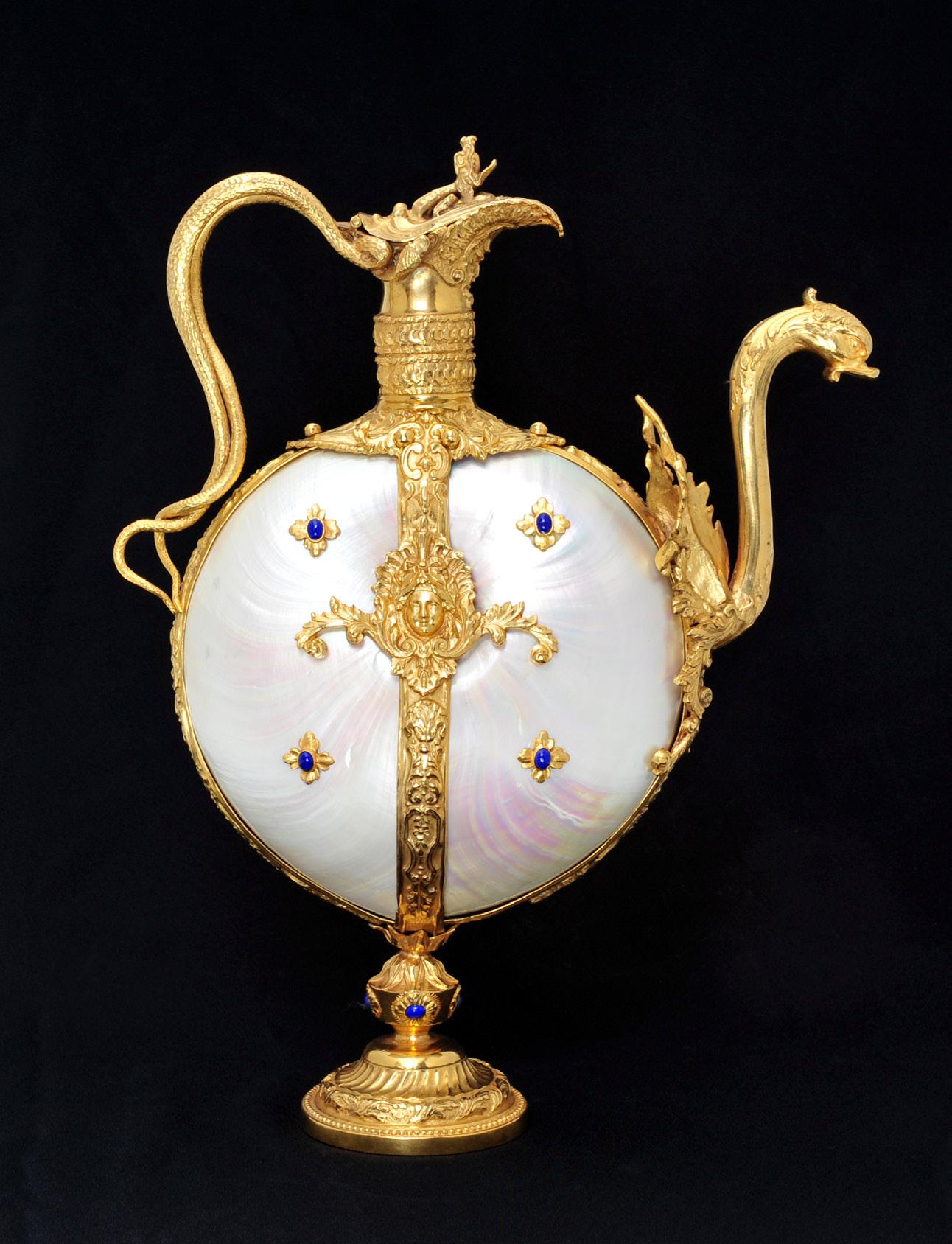
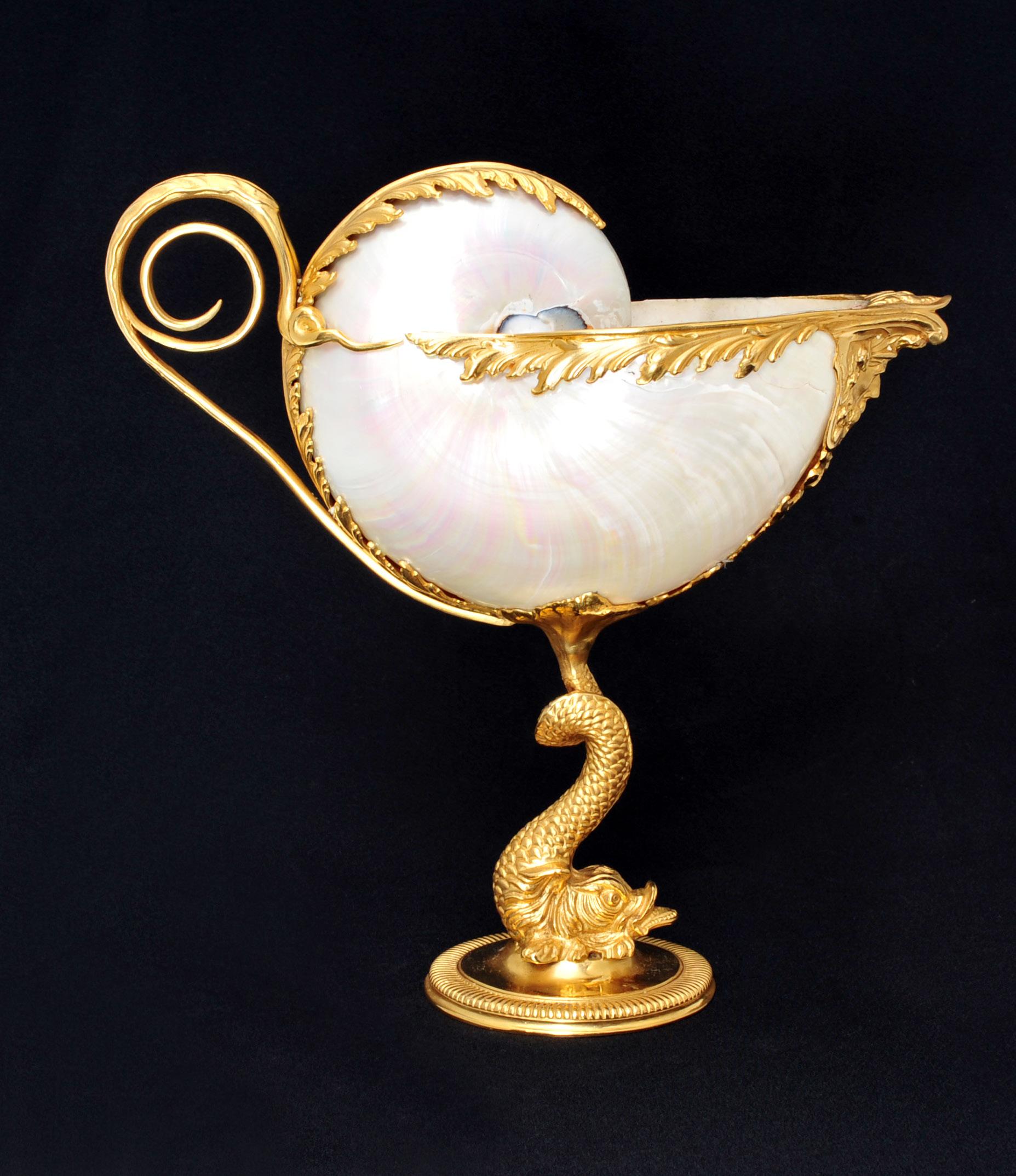
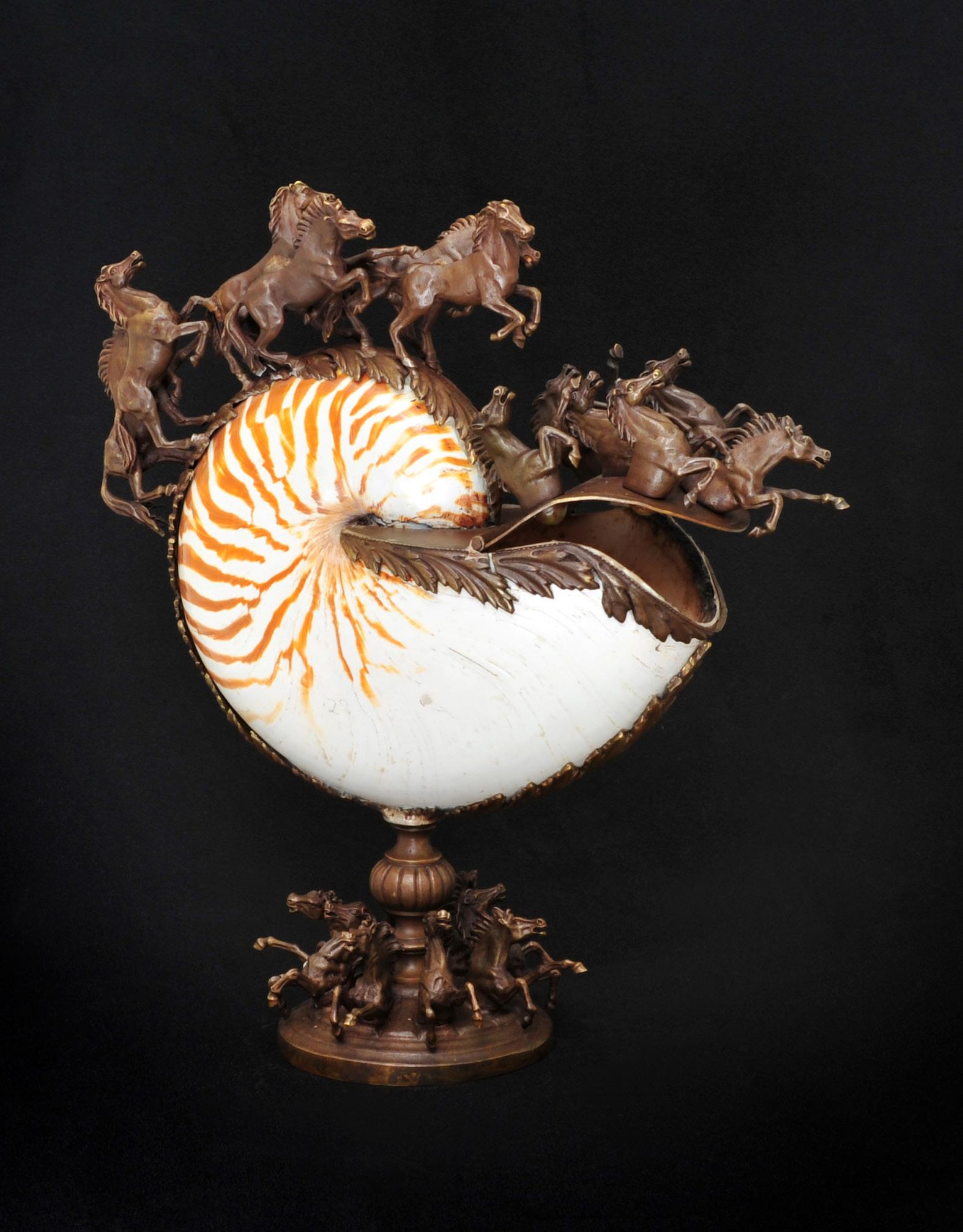 Fig. 1
Fig. 3
Fig. 2
Fig. 4
Fig. 1
Fig. 3
Fig. 2
Fig. 4
Germany, a seventeenth-century nautilus shell was found in the Schwerin castle collection of Duke Christian Louis I of Mecklenburg (1623-1692, reign 1658-1692). This same piece was later described in the inventory of the Duchess of Châtillon and Mecklenburg-Schwerin Isabelle Angélique (born Isabelle Angélique de Montmorency, 1627-1695).6
Examples of nautilus shell vessels still exist today as their precious metal embellishments were rarely melted due to the underlying appreciation of the Nautilus pompilius as an object of beauty and mirabilia naturarum (“natural miracles”). These exotic nautilus shells have contributed to the protection of the crafted antique vessels and their presentation over the centuries. Exquisitely restored examples of the Nautilus pompilius vessels can be seen today in the Grünes Gewölbe (The Green Vault), the National Museum of Dresden, and the National Museum of Schwerin in Germany.
Gaube du Gers has designed and embellished a new collection of Nautilus pompilius with pearls and silver, gilded bronze, and fine gold. Some of the objects are even decorated with precious stones. Gaube du Gers’ collection is accompanied by pastel drawings of each piece created by the artist himself and watercolors executed by Gaube du Gers’ daughter, artist Marie-Anita Gaube.
“A collection is often born from a bundle of circumstances,” explains Gaube du Gers. Five years ago, when he acquired a set of Nautilus pompilius, it sparked his imagination. The artist explains that while holding a nautilus in his hands his imagination began to fly. “The idea of creating a collection as an invitation to dream and leave this time of ‘crisis,’ I wanted to translate these objects into an emotionally charged ‘ballad.’”7 The completion of this art project has taken several years.
Gaube du Gers’ work is found in private collections throughout the world. He describes his art poetically by defining, “[My] artistic concept wonders without a specific goal and finds its inspiration during the time and circumstance present at the moment. This aesthetic concept then transforms itself through [my] technique into the art object. The fruit of [my] production comes from the heart through the landscape of my hands. Whatever the observer sees, there is always a proposed message, a desire to share, to elevate the soul because there is no art without spirituality.”8
The La Conchyliografia collection is based on an artistic reference to the sixteenth and seventeenth centuries with a contemporary interpretation that retains a stylistic timelessness. The artwork is referenced with five distinct themes: India, Classicism, Equestrian Movement, Biblical References and finally what Gaube du Gers identifies as “The Bosch Suffering” (Tourments Boschiens)—an allusion to Netherlands fifteenth-century painter Jérôme Bosch (born Hieronymus Bosch, c. 14501516) and his works. The collection’s accompanying catalogue has five chapters with descriptions of each piece and showcases as well as identifies the artwork individually.
Chapter one is dedicated to India, inspired by an Indian aesthetic. Influence of nineteenth-century French Empire decorative motifs is also present, and relates to the French renowned silver manufacturer JeanBaptiste Claude Odiot.
“Bombay” (Figure 1) represents the nautilus shell with a silver hemmed edge, covered in a mesh-like sterling silver arabesque net that is set with turquoise and onyx. The shell rests on a silver column pillar and round base. The movement of the arabesques reflects the curvilinear style of native Indian patterns. Another piece from
Fig. 5. “Prix de l’Arc” is French for the “Price of Arc.” This piece shows an equestrian gilded bronze sculpture of a horse’s half-body and nautilus shell representing the embodiment of victory and power of movement. Horses are ever present in ancient mythology, are sacred animals and usually relate to the triumph over negative forces. Horses were also symbols of energy and have been seen as majestic animals with wisdom and power. The year of 2014 in the Chinese zodiac is the year of the Horse.
Fig. 6. “Jardin d’Eden” is French for the “Garden of Eden.” This piece incorporates a Nautilus pompilius, red coral and gilded bronze. It symbolizes the conflict of the Garden of Eden’s forbidden fruit. The base beneath the shell represents the forbidden fruit tree and the devil is symbolized by the gilded dragon scaling the tree. The color configuration between the white nautilus shell, the gilded bronze and red coral contribute to the dramatic plot of the conflict of good and evil.
Fig. 7. “L’Arche de Noé” is French for “Noah’s Ark,” depicts the nautilus shell as the ark. The shell has a gilded wood-like structure and rests on a sterling silver rock representing Mount Ararat where Noah’s Ark came to rest after the great flood. The bow of the ship supports a dove with spread wings and holds an olive branch in its beak, while pairs of animals board the ship with Noah looking on as their protector. The meaning of the enlarged Noah figure is to reference him as the “second Adam,” from whom came all creations and who saved all species.
Fig. 8. “Les Damnés” is French for “the Damned.” This piece is another representation of the good and evil. The natural purity of the nautilus shell symbolizes the good, whereas the nude dark muscular figures battling a dragon represent the conflict with the evil. According to Gaube du Gers, this scene is a pictorial metaphysical representation often found in early sixteenth-century Dutch painter Hieronymus Bosch’s paintings. The suffering figures are in a state of torture, referring to the man “being tormented through his fragile nature between earth, heaven, and hell.”
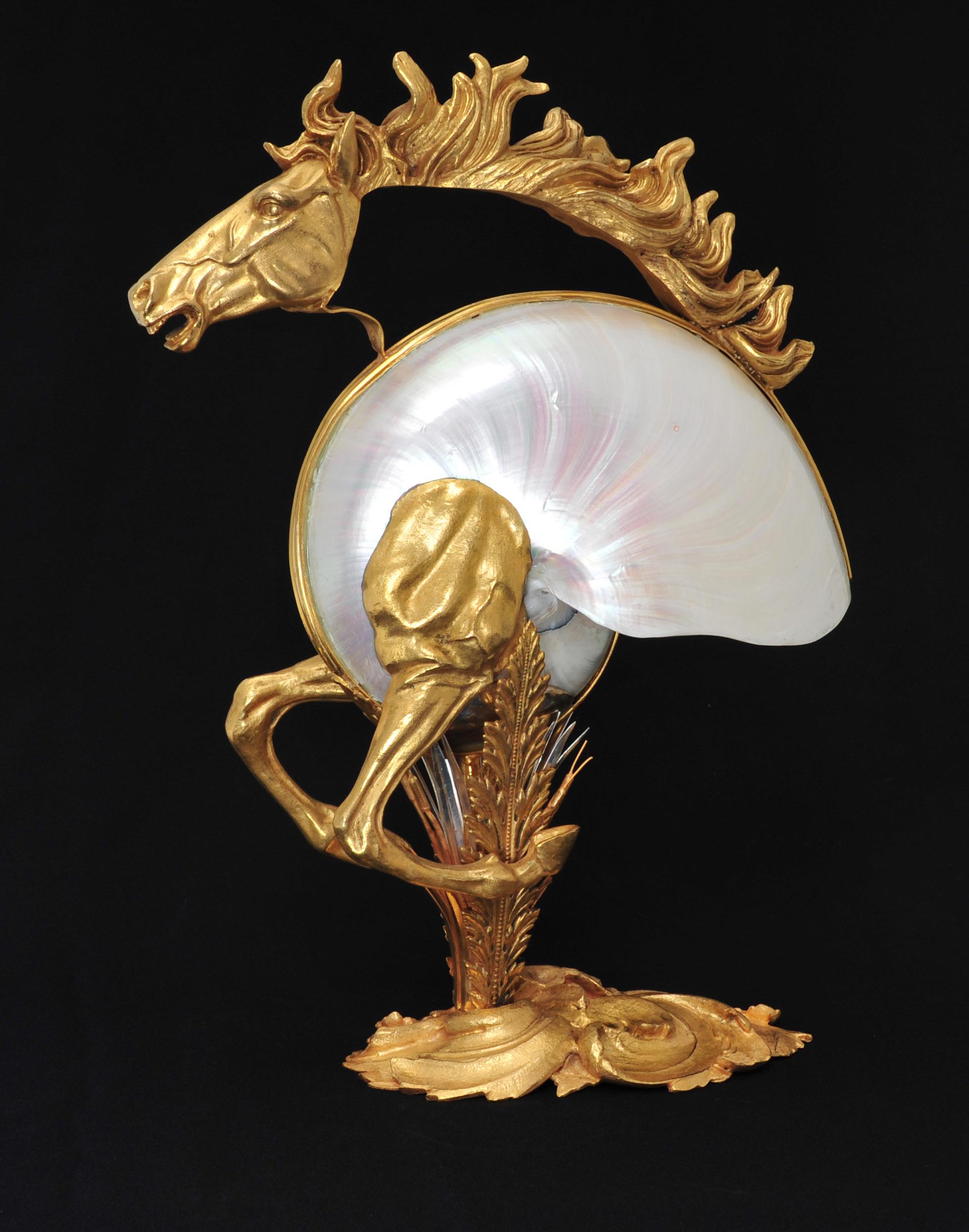
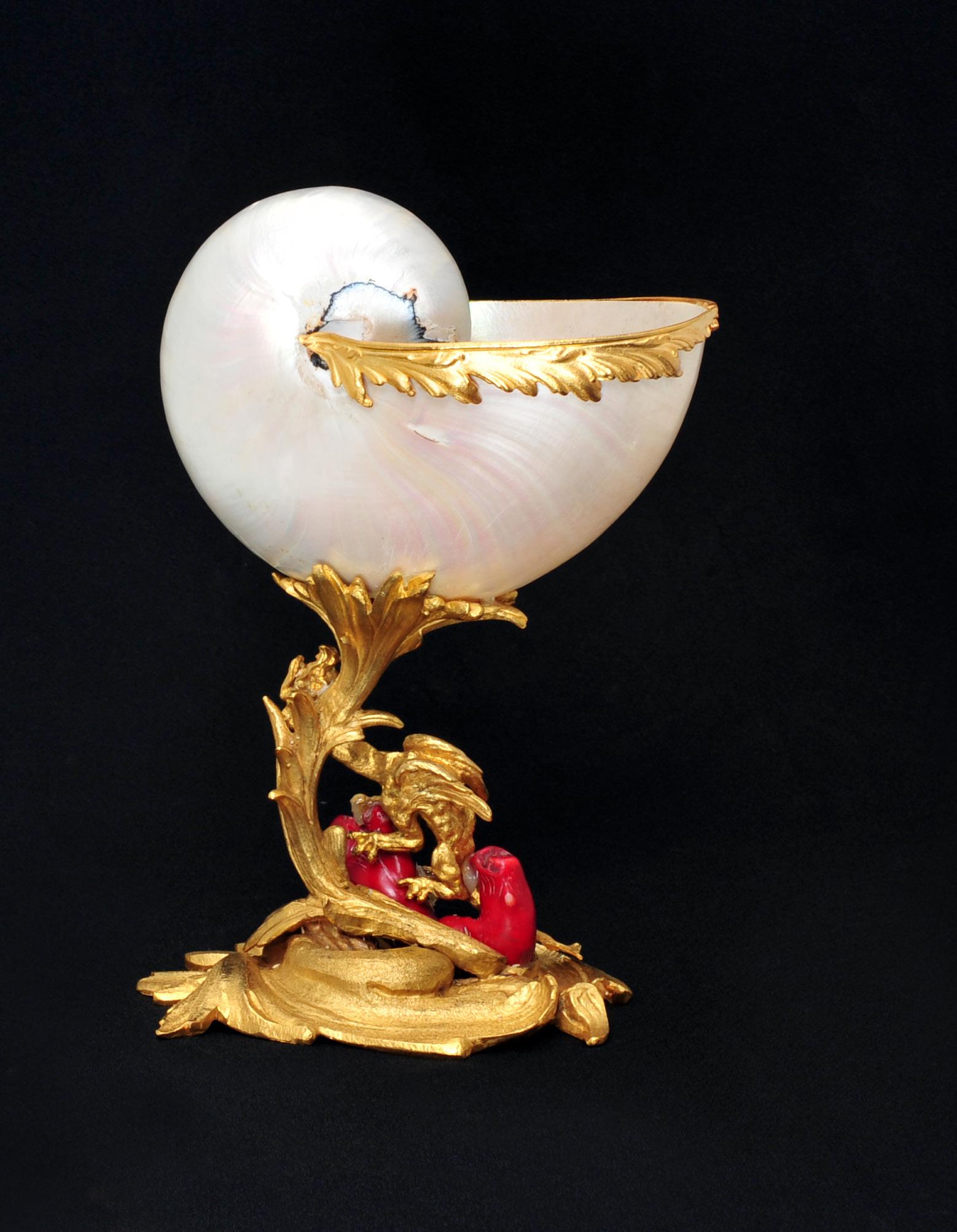

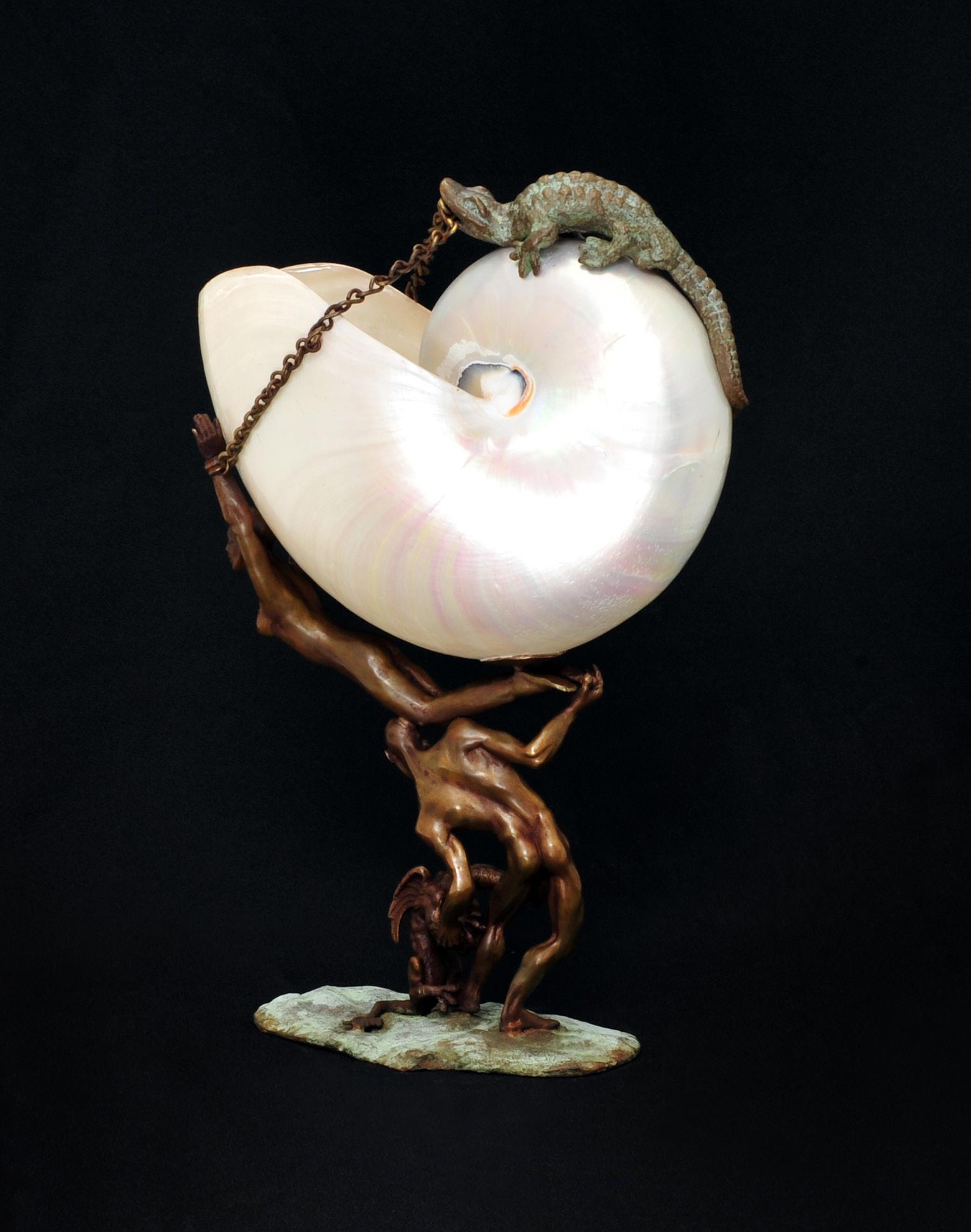 Fig. 5
Fig. 7
Fig. 6
Fig. 8
Fig. 5
Fig. 7
Fig. 6
Fig. 8
the same series, “Acanthus” (Figure 2), is more reminiscent of the French Empire period because of the decorative Empire sculptured dolphin motif at its base. The gold-gilded dolphin supports the shell that is wrapped in a foliated acanthus leaf evoking the look of algae and elegantly rests on a round gadrooned base. A delicate scrolled pitcher handle in the form of a leaf graces the vessel as does the front spout opening that features the head of Poseidon. During the French Empire period, silversmiths applied ornaments according to the function of the object. Therefore, most antique vessels intended for liquids displayed the iconography of the water, such as Neptune, dolphins and swans, and their attributes. This French Empire influence is recognizable throughout the entire Indian series.
The second chapter emphasizes classical forms and ornaments. The first example, the Italian “Mesciroba” (Figure 3) is a shell that becomes a vase with a handle and a spout similar to ones used by nobility during the Renaissance. He explains that this artwork has been inspired by a collection of treasures that once belonged to the Grand Duke of Tuscany Ferdinand I of Medici of Florence. Gaube du Gers composed his “Mesciroba” of two Nautilus pompilius attached to a complex mount of gilded bronze, enriched with inset lapis lazuli throughout. The two shells rest on a circular base, from which three bands unravel: one of pearls, one of leaves, and one of grooves. Towards the center of the two shells are two medallions with anthropomorphic busts. The spout has the form of a chimera head, at the neck of which is tied through floral wings. Two delicately intertwined snakes form handles of the “Mesciroba.” There are historically similar forms; one almost identical, is the sixteenthcentury “Mesciroba” composed of a double nautilus, gilded silver, rubies,
and turquoise. The piece is part of the Medici Treasury collections at the Museo degli Argenti in Florence, Italy. Chapter three is devoted to the horse and equestrian movement. In the introduction, Gaube du Gers describes the movement he sees in the nautilus shells: “The nautilus shell conveys a power of movement that is characterized by the structure and form of the shell. The white background with orange spiral waves alludes to the movement of equestrian galloping.”9 This movement is visible in the piece “La Chevauchée Fantastique” (Fantastic Cavalcade) (Figure 4), which features the equestrian jumping in a group of horses floating on a large acanthus leaf. Another example of the equestrian movement from this series is the “Prix de l’Arc” (Price of Arc) (Figure 5). The horse with its fringed mane flowing in the breeze has a powerful panache. The figure and nautilus are a contrast of material; one with the equestrian figure modeled of gilded bronze and the other a fragile nautilus’ motherof-pearl natural shell structure. The base consists of gilded bronze reeds bordering sculptured acanthus leaves. Gaube du Gers explains the equestrian movement of the piece as one that “evokes a race at the International Grand Prix de l’Arc de Triomphe on the celebrated field of Longchamp.”10
In chapter four, Biblical references represent traditional scenes from the Bible’s Old Testament. “Jardin d’Eden” (Garden of Eden) (Figure 6) is the Nautilus pompilius piece that symbolizes the conflict of the garden’s forbidden fruit. The French inspired motif of the acanthus leaf border on the nautilus’ edge protects the white mother-of-pearl “innocence” that the animated dragon is approaching and attempting to seize on the red coral section of the stem. In another Biblical scene entitled “L’Arche de Noé” (Noah’s Ark) (Figure 7), the nautilus shell is
meant to portray the ship that invites animals aboard. The shell, which accommodates a gold gilded wooden structure on top, rests on a rock of silver representing Mount Ararat where Noah’s Ark came to rest after the great flood. The bow of the ship carries a dove with spread wings that holds an olive branch11 in its beak, while pairs of animals board the ship with Noah looking on as their protector.
The last chapter references the Netherlands fifteenth-century painter Hieronymus Bosch and his playful translation of fantasy imagery that portrays moral and religious concepts. Bosch was an important inspiration of the La Conchylografia collection. Gaube du Gers explains, “Our humanity, from its origins to its end, changes and transgresses facing a divine order; its pleasures and ‘nightmares’ are what I describe as ‘torments.’ Both the man and turmoil have a fragile nature, and are torn between good and evil...”12 Similarly, the figures in Bosch’s paintings that represent good and evil are reflected in Gaube du Gers’ work “Les Damnés” (The Damned) (Figure 8). The natural purity symbolized in the white fluidity of the nautilus shell represents the good, whereas the nude muscular figures battling a dragon represent the conflict with evil. This conflict of good and evil provokes, and awakens a monster, the crocodile positioned on top of the nautilus shell. Gaube du Gers explains that this scene is a pictorial metaphysical representation that is often found in Bosch’s paintings. He calls the struggling figures in a “state of torment,” and “man being tormented through his fragile nature between earth, heaven and hell.”13
Gaube du Gers clarifies that his La Conchyliografia collection reflects “a directory of dreams where nature, drawn from its long history of millions of years is associated with the material of creating future dreams...in a burst
of precious blends of history, humor, the Pythagorean rigor, future and fantasy.”14
The La Conchyliografia exhibition was inaugurated at an opening at Lapparra’s Paris showroom less than a year ago and was accompanied by a beautiful catalogue. Gaube du Gers uses a pseudonym instead of his name as author of the catalogue to symbolize the importance of past artistic achievements. His catalogue features the pseudonym “Joan van Kaup de Jer,” as a reminder that these kinds of pieces of Nautilus pompilius
Notes:
1. Olivier Gaube du Gers, Odiot l’Orfèvre (Paris: Editions Sous le Vent, 1990).
2. Hans-Ulrich Mette, Der Nautiluspokal: wie Kunst und Kultur miteinander spielen (München: Klinkhardt und Biermann, 1995), 30.
3. For more information on Curiosity Cabinets see: Patrick Mauriès, Cabinets of Curiosities (New York: Thames & Hudson, 2011); and Thomas DaCosta Kaufmann, “Remarks on the Collections of Rudolf II: The Kunstkammer as a Form of Representation,” Art Journal 38, (Fall 1978), 22-28.
4. Olivier Gaube du Gers, interview with author, February 2014.
5. Hans-Ulrich Mette, Der Nautiluspokal, 95.
6. Karin Annette Möller, Schimmern aus der Tiefe: Muscheln, Perlen Nautilus (Imhof Verlag, Staatliches Museum Schwerin, 2013), 149.
7. Olivier Gaube du Gers, interview with author, February 2014.
8. Ibid.
were often represented in paintings and engravings by great Flemish masters. In fact, some pastels by Gaube du Gers evoke the Old Master paintings of that era. The artist explains, “Everyone can find from a particular part of the artwork that relates to an essence of his imagination.”15 Gaube du Gers continues by saying, “I’ve learned the craft of silversmithing over many years and love the touch of metal in general, which gives me a deep desire to transform it.”16 Gaube du Gers’ La Conchyliografia collection is an example of the highest quality of
gold- and silversmithing being crafted today, and the esthetic underlying and meaningful symbolism that he employs in his work goes beyond any measure of creativity.
Karolina Stefanski was awarded a Master’s degree in Art History from the Institut National d’Histoire de l’Art at Sorbonne University, Paris, and is a Ph.D. candidate at the Technical University of Berlin. She can be reached at polycletus@gmail.com.
9. Johan van Kaup de Jer, La Conchyliografia: de l’origine à la creation (Paris: Lapparra, 2013), 43.
10. Olivier Gaube du Gers, interview with author, February 2014.
11. The olive branch is a symbol of peace and victory and originated in Ancient Greece where a “crown of wild olive was the highest award of the Olympian games.” See: Maureen Stafford and Dora Ware, An Illustrated Dictionary of Ornament (New York: St. Martin’s Press, 1974), 154.
12. Olivier Gaube du Gers, interview with author, March 2014.
13. Olivier Gaube du Gers, interview with author, February 2014.
14. Ibid.
15. Ibid.
16. Ibid.
1) Credit Card/Paypal through our website - Silvermag.com
2) Paypal directly to Silvermag33480@gmail.com
3) Check to PO Box 2284, Palm Beach, FL 33480
4) Telephone order to (561) 290-4773
